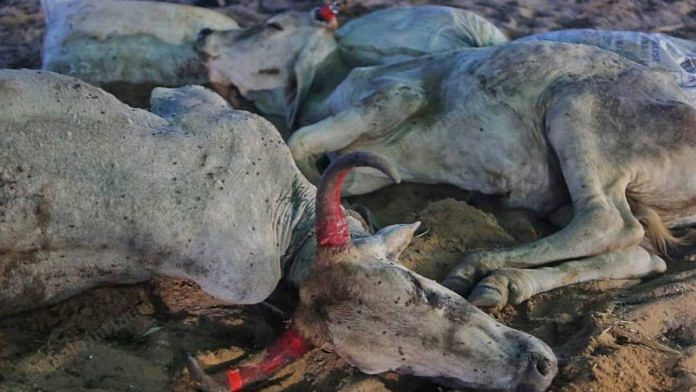Gandhidham (Gujarat): Lumpy skin disease (LSD) — a viral cattle outbreak — has been wreaking havoc in several Indian states, including Gujarat, Rajasthan, and Punjab, killing a reported at least 8,000 animals in the past few weeks, though ground workers claim the numbers to be much higher.
Cases have also been reported from Haryana and Himachal Pradesh.
Typically, LSD outbreaks occur in epidemics several years apart. The current one began in India in July 2022, but had been spreading in Pakistan for a few months before that. Whether there is a specific animal reservoir — a species that hosts the virus, but does not get sick — is not known. Nor is it known how and where the virus survives between epidemics.
Outbreaks are usually seasonal during rains, but may occur at any time because none of the regions affected are free of vectors that spread the disease — such as mosquitoes, flies and ticks.
“There are reports of international transport of disease because of change in wind velocity and directions, as a part of climate change. When the winds changed, the insects carrying the virus are believed to have been redistributed to previously uninfected countries,” Dr. Rathish R. L., assistant professor, department of Veterinary Epidemiology and Preventive Medicine, College of Veterinary and Animal Sciences, Pookode, Kerala, had told ThePrint last week.
He added: “Growing numbers of animals which have never suffered from the disease (those once infected will be more immune to the virus), abundance of active blood-feeding vectors, and uncontrolled animal movements are usually what causes LSD outbreaks.”
The first case is usually associated with the introduction of new animals into, or in close proximity to, a herd.
Death rate is usually less than 10 per cent. The vulnerability of an animal depends on its immunity status, age, and breed.
Usually, high milk-producing, thin-skinned European cattle breeds are more susceptible to the disease compared to indigenous African and Asian animals which have thicker skin — thought to be more resistant to the virus.
Cows that produce more milk are usually most severely affected. “Animals with high production (capacity) can be more stressed,” explained Rathish. The body’s faculties are diverted to milk production, hence they may become more susceptible to diseases and infections, he added.
The disease can be asymptomatic in some animals, which is how it can spread inconspicuously to others.
ThePrint draws upon its observation in Kutch — one of the worst-affected districts in Gujarat, according to the district administration — extensive research and interviews with veterinary doctors, on-ground workers, and experts, to draw up a profile of the disease.
Also read: In Kutch, students step in as vet shortage adds to challenges in lumpy skin disease battle
Caused by virus belonging to same family as monkeypox virus
Lumpy skin disease is caused by the lumpy skin disease virus (LSDV), a member of the Capripoxvirus (CaPV) within the Poxviridae family — the same family which causes monkeypox — the outbreak of which was declared a global health emergency by the World Health Organisation last month.
Lumpy skin disease virus shares the genus with sheep pox virus (SPPV) and goat pox virus (GTPV), which are closely related.
LSDV is a large, double-stranded DNA virus that is very stable, and mutates very slowly.
As a result of this, the virus’ farm-to-farm spread cannot be followed by sequencing the virus samples.
This is in contrast to bovine diseases like foot-and-mouth disease, which has small genetic variations while it spread from one animal to another, leaving telling footprints of how the disease spread.
Lumpy skin disease is widespread and endemic throughout Africa, excluding Algeria, Morocco, Tunisia, and Libya.
It is host-specific, causing natural infection in cattle and Asian water buffalo (Bubalus bubalis).
However, for buffalo, the disease severity and death rate are much lower due to their higher natural immunity compared to cows, say experts.
Some LSDV strains can also replicate in sheep and goats. They have also been known to have affected giraffes and impalas.
Lumpy skin disease does not affect humans.
Symptoms and recovery
The first case of LSD can often be traced to the legal or illegal transfer of cattle between farms, regions, or even countries.
In fact, the movements of cattle may allow the virus to jump over long distances, say experts
The incubation period in animals varies between four and seven days, but it may also last up to five weeks.
The disease gets its name from the large, firm nodules that develop on the skin of cattle as a result of the disease.
Clinical signs include nasal discharge — usually the first to be observed.
This is followed by a high fever which may persist for approximately a week, followed by a sharp drop in milk yield.
The cattle then develop lumps of 10-50 mm in diameter. The cattle also develop swollen limbs.
Sometimes, painful ulcerative lesions develop in the cornea of one or both eyes,
leading to blindness in the worst cases. The pox lesions also develop throughout the entire digestive and respiratory tracts and on the surface of almost any internal organ.
Recovery period may vary between two weeks to a month, said Dr. Girish Parmar, a veterinary physician in Gujarat’s Kutch. For those more severely infected the recovery process may be slower.
There is currently no specific antiviral for the disease and most treatment is symptomatic. Vaccines being administered in India are the same as that for goatpox virus.
(Edited by Poulomi Banerjee)
Also read: In Kutch camps, sick cows gnash teeth, flies cover wounds, as they wait to die of lumpy skin disease



